Best Fruit Tree Choices for the Texas Gulf Coast and the Southern US
Citrus and Fresh Organic Fruit are Part of a Nutritious and Well-Rounded Diet; Save Money, Grow Your Own
Copyright © Kelly Smith; all rights reserved; content may not be copied, rewritten, or republished without author’s written permission; Author’s Google profile; Posted January 08, 2012
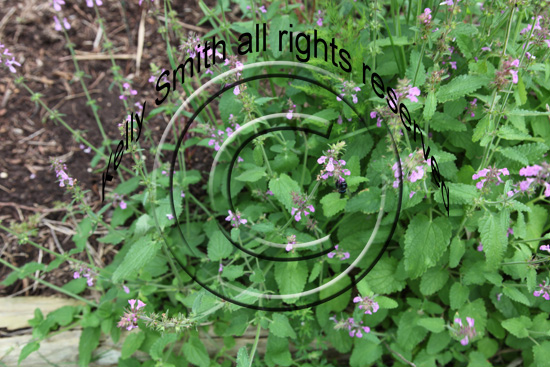

Fruits such as apples grow well in the cooler northern states such as Washington and even as far south as the Ozark Mountains in Arkansas where they get enough chill hours during the winter. And then of course tropical fruits like grapefruit do well starting around the Rio Grande Valley and further south. But for areas mid to south Texas and other Gulf States, tree selection must be done cautiously.
Try the Improved Meyer Lemon

 The Improved Meyer enjoys a history that goes back some way. Originally, the species was introduced from the country of China by Mr. Frank Meyer in the early 1900s. Sadly, a citrus virus wiped out this species locally in the 1940s. But researchers developed improved version during the 1970s and the rest is history.
The Improved Meyer enjoys a history that goes back some way. Originally, the species was introduced from the country of China by Mr. Frank Meyer in the early 1900s. Sadly, a citrus virus wiped out this species locally in the 1940s. But researchers developed improved version during the 1970s and the rest is history.
This tree has been recommended as a large container plant. This makes it a prime choice for apartment-bound farmers and folks with small yards. One of the advantages I like is that the flowering and subsequent crop is more or less continuous over wide time frame instead all at once as a fall crop. The lemons are a bit smaller, less tart, but much tastier than grocery store lemons.
Small-space container gardens are gaining in popularity as people are favoring as-fresh-as-possible organic produce and herbs.
Plant an Opal Avocado
One problem with avocado trees is that the occasional hard freeze can ruin your day. But we do have some options available to us. The Opal is derived from Mexico, grows well in the Gulf Coast area, and can tolerate our light freezes.
This tree can get quite large and take up a lot of your gardening space. So why invest in an avocado tree? Because avocados are are so expensive at the grocery stores! Some crops just have no justification being priced so high. Avocados, mangos, and asparagus fall in this category.
Try Malta or Celeste Figs
The Celeste an often recommended fig variety for the Gulf Coast but is widely-acknowledged as one of the best for all of Texas. The crop is prime around the middle of June if you can keep the birds at bay. Give it plenty of sun and little if any pruning.
There are some other varieties that work well in this area. Try the Brown Turkey (Texas Everbearing), the Alma, and the Kodota, which is known as a commercial crop in California.
Try the Sam Houston Peach Tree
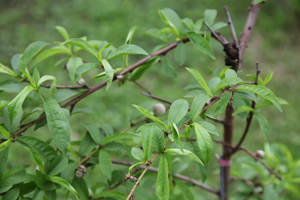 The name should tell you all you need to know. Nothing says Texas like “Sam Houston.” This tree is very large when it matures; expect it to reach 30 feet tall by 30 feet wide, so don’t locate it too close to your home’s foundation. If you decide to plant more than one, leave sufficient space between them.
The name should tell you all you need to know. Nothing says Texas like “Sam Houston.” This tree is very large when it matures; expect it to reach 30 feet tall by 30 feet wide, so don’t locate it too close to your home’s foundation. If you decide to plant more than one, leave sufficient space between them.
The flowers this peach tree putts out are pinkish reddish, with a bit of yellow in the center; expect plenty of pollinating bees (a good thing). Texas A&M developed this variety, but a dwarf has also been developed. One thing I like is that it is a freestone peach (the meat is loose on the pit) which makes if a bit harder to chip your teeth.
Peach Tree Updated 08/15/12 — I was surprised at how fast this tree grows, and here is the visual. The photo on the left below was taken shortly after I planted it in March 2011. The second picture is from today, August 15, 2012.
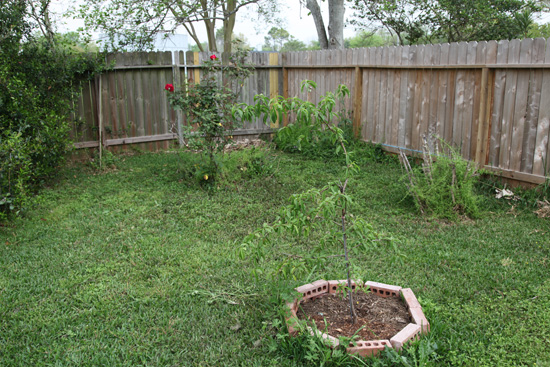
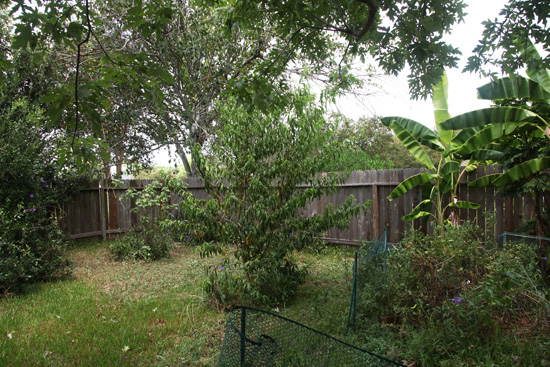
Try the Owari Satsuma Mandarin Orange Tree
These are small oranges that mature right on the tree beginning in November. They are far superior to the ones packed in heavy syrup from the grocery store. The skin is easy to remove from the fruit, similar to tangerines.
The Republic of Texas Orange
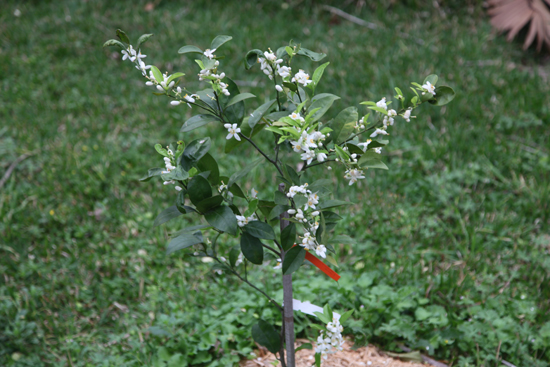

The small tree pictured above was planted one spring ago. That first year yielded one orange, but of course all the energy was going into root development, not fruit production. After one year on an organic program, you can see what this year’s harvest promises.
The fragrance of the flowers is sweet and intense, and bees are very attracted to them. This variety has been grown in Texas since the mid-1800s. It’s a thorny, cold-tolerant citrus tree.
It blooms in the spring and yields medium-size oranges in December. It will eventually grow to about 15 feet tall, so it is not only easy to harvest, but is also a good choice for the smaller yards common in modern subdivisions.
A raised-bed vegetable garden is one good way to provide nutritious, low-cost food for your family but why not expand your home farm to include a mini-orchard?.
Sources:
- www.MeyerLemonTree.com
- www.Aggie-Horticulture.tamu.edu/extension/homefruit/fig/fig.html
- www.CaldWellHort.com/html/fruit_trees.html
Follow Kelly Smith on Pinterest
More Organic Gardening and Food Articles
- The Organic Method of Planting a Tree
- Build a Raised Bed Vegetable Garden
- Organic Foliar Feeding with Garrett Juice
- Balanced Soil is the Foundation of Organic Gardening
Website © 2012 KSmith Media, LLC; all rights reserved.


